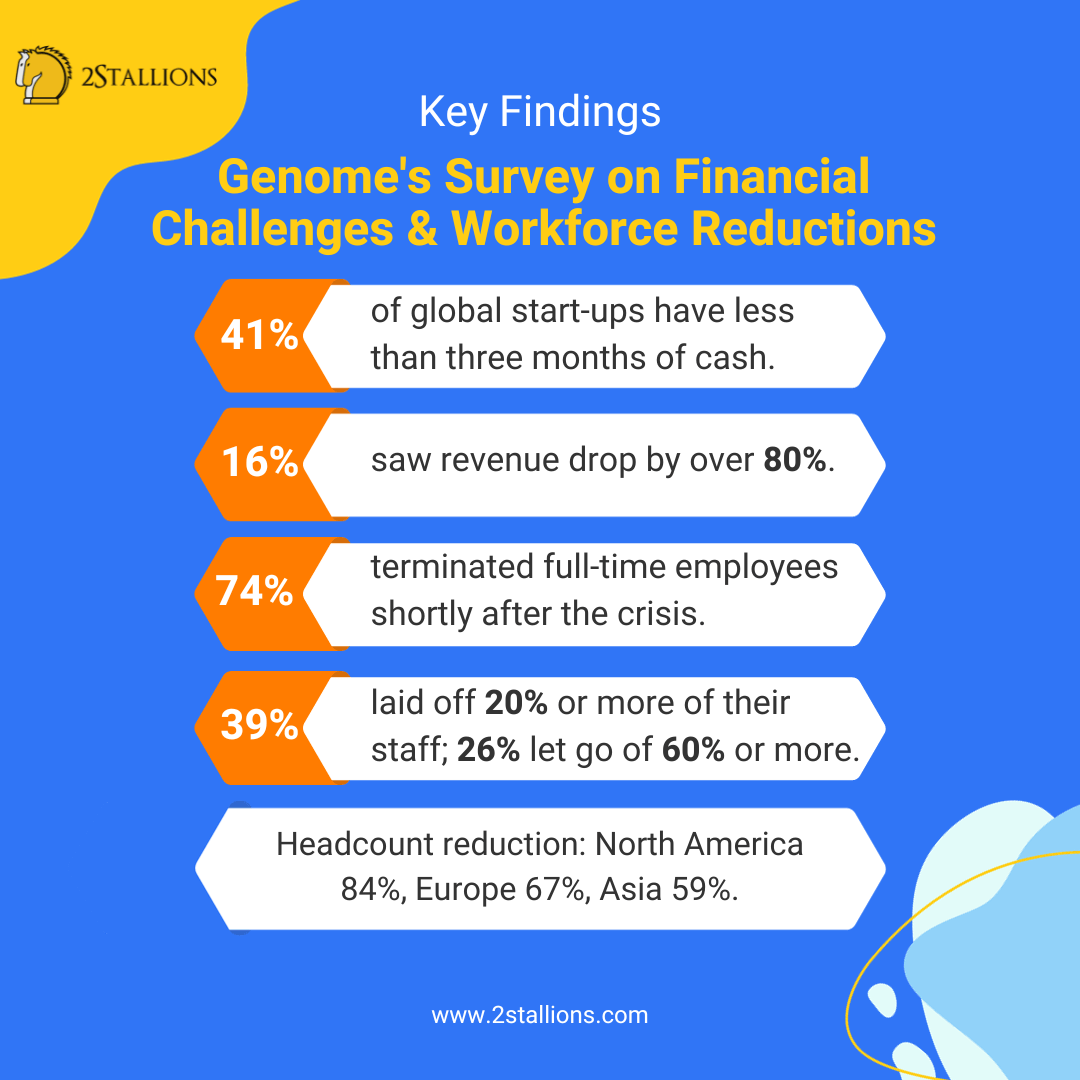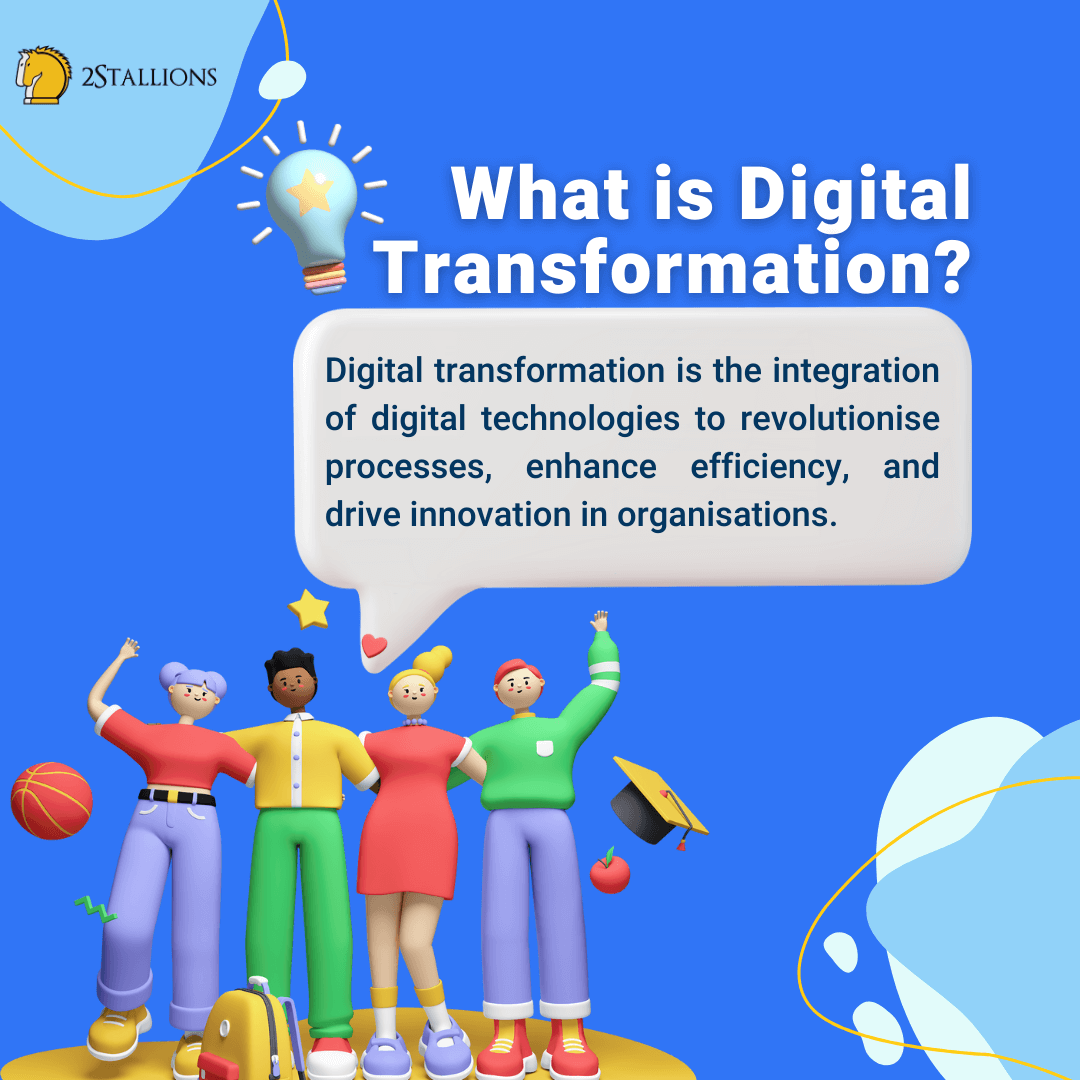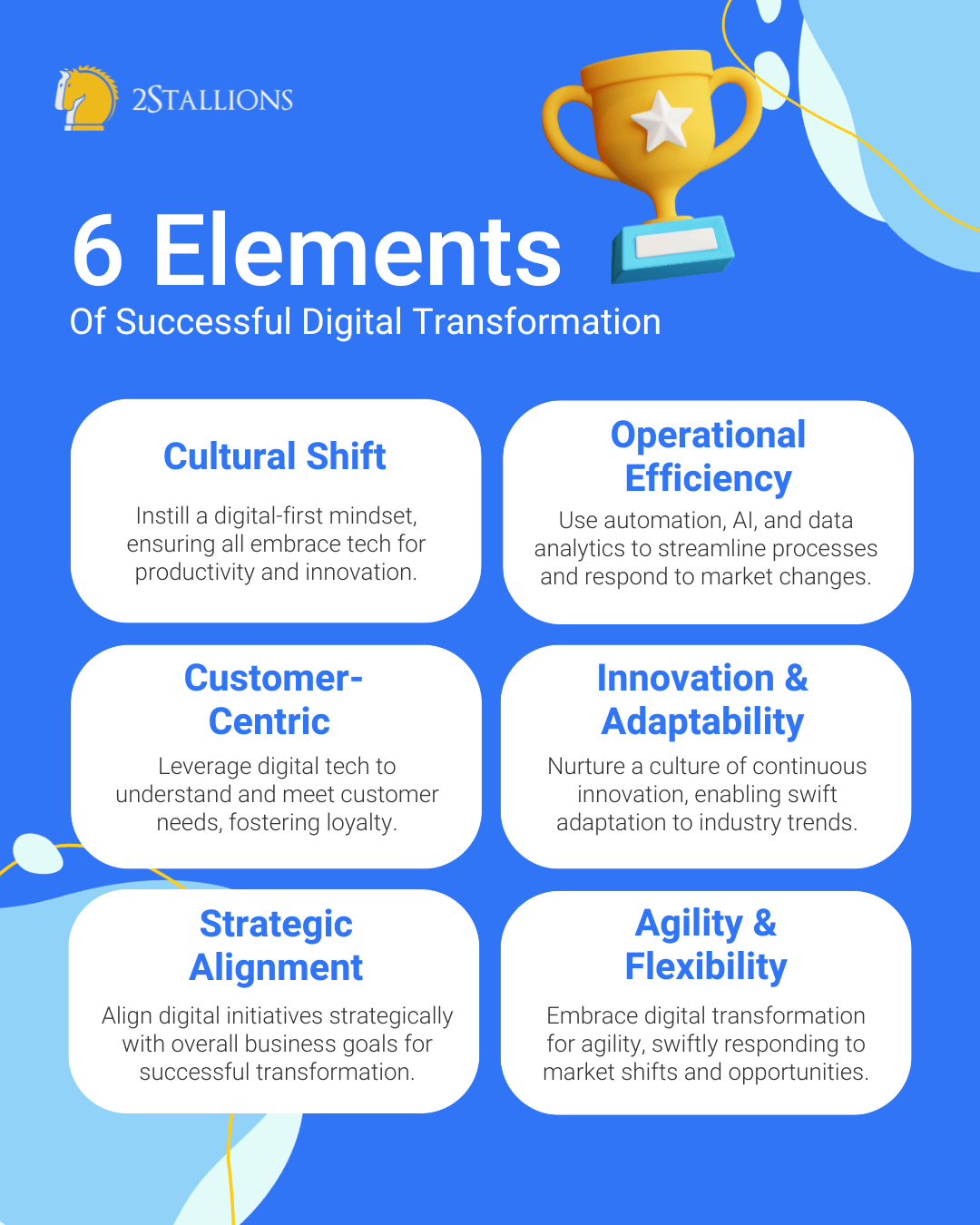Content
SHARE

While a tragedy, the COVID-19 crisis in 2020 has catalysed a continued wave of digital transformation and innovation. Businesses have adapted to the challenges posed by the pandemic and recognised the critical role of digital technology in securing their future. A study by McKinsey & Company reveals that the pandemic acted as a catalyst, pushing companies to expedite their digital initiatives. As reported in the study, this acceleration in digital adoption signifies a profound shift compared to pre-crisis times, indicating a lasting impact on business strategies.
Digital Transformation as a Response to Challenges
The onset of COVID-19 presented unprecedented challenges for businesses globally, ranging from ensuring the safety of employees and customers to managing operations and navigating governmental support programs. The impact was particularly severe for smaller entities, with start-ups facing mass layoffs just weeks into the crisis. Genome's Global Start-up Survey underscores the harsh realities start-ups face:
Micro, small, and medium enterprises (MSMEs) also grapple with survival, as the ILO SCORE Global Covid-19 Enterprise Survey indicates. The findings reveal that 70% of MSMEs had to close operations, and nearly 9 out of 10 faced cash flow shortages, severely impacting business continuity.
Business Closures Across Sectors
Another study also found that the sectors with the most business closures globally were the following:
- Travel or tourism agencies (54%)
- Hospitality and event services (47%)
- Education and child care services (45%
- Performing arts and entertainment (36%)
- Hotels, cafes, and restaurants (32%)
Despite these challenges, the pandemic has spurred entrepreneurial resilience. Many businesses pivoted their offerings to align with the crisis, providing essential services such as face masks, commercial cleaning, and delivery services. Moreover, businesses that successfully navigated the pandemic did so by accelerating their digital transformation efforts.
The embrace of digital technologies has proven to be a lifeline for operational continuity and resilience in an ever-evolving business landscape. As we move forward into 2024, the lessons learned from the pandemic underscore the enduring importance of digital transformation for businesses aiming to survive and thrive in a dynamic and uncertain future.
What is Digital Transformation?
Digital transformation is a comprehensive and revolutionary process that involves the deep integration of digital technologies into every facet of a business. It's not merely about incorporating new tools or software; rather, it signifies a fundamental shift in the organisational culture. This paradigm change is aimed at leveraging technology to its fullest potential, redefining how the business functions, and reimagining how it delivers value to its customers.
The essence of digital transformation lies in transcending traditional boundaries and embracing a holistic approach to technology integration. It is about rethinking strategies, processes, and interactions, aligning them with the possibilities afforded by cutting-edge digital tools. This transformative journey extends beyond the surface level, reaching into the organisation's core and instigating a cultural metamorphosis that embraces innovation, adaptability, and a forward-thinking mindset.
Successful Digital Transformation
A successful digital transformation is not measured merely by the adoption of digital tools but by the profound impact it has on the entire operational landscape of a business. Here are key pillars defining a triumphant digital transformation:
- Cultural Shift: Achieving successful digital transformation requires instiling a digital-first mindset across the organisation. This entails a cultural shift where all employees embrace technology as a facilitator, integral to their work ethos. It ensures every team member leverages digital tools for improved productivity and innovation.
- Enhanced Operational Efficiency: Digital transformation aims to streamline processes and operations, eliminating inefficiencies and bottlenecks. Automation, artificial intelligence, and data analytics are harnessed to optimise workflows, enabling the business to operate more efficiently, allocate resources judiciously, and respond dynamically to changing market conditions.
- Customer-Centric Approach: The heart of digital transformation lies in delivering unparalleled customer experiences. By integrating digital technologies, businesses can understand, anticipate, and fulfil customer needs more effectively. This customer-centric approach fosters loyalty and positions the business as a dynamic and responsive player in the market.
- Innovation and Adaptability: A successful digital transformation fosters a culture of continuous innovation and adaptability. It empowers the organisation to stay ahead of industry trends, embrace emerging technologies, and swiftly adapt to changing market dynamics. This innovative spirit becomes a competitive advantage, enabling the business to thrive in a rapidly evolving landscape.
- Strategic Alignment: Digital transformation is not a one-size-fits-all endeavour. It requires a strategic alignment of digital initiatives with overarching business goals. Successful transformation initiatives are strategically planned, ensuring that technology integration aligns seamlessly with the broader vision and objectives of the organisation.
- Agility and Flexibility: Embrace agility and flexibility in your digital transformation journey. Swiftly adapting to market shifts, technological advancements, and customer expectations defines a digitally transformed organisation. This agility enables navigating uncertainties and seizing emerging opportunities.
A successful digital transformation is a holistic and strategic undertaking permeating every layer of an organisation. It is a journey marked by cultural evolution, operational refinement, customer-centricity, innovation, strategic alignment, and the cultivation of agility. As businesses navigate the complexities of the digital era, a triumphant digital transformation is not just an option but a prerequisite for sustained relevance and competitiveness in the modern business landscape.
Netflix's Agile Digital Transformation Amid COVID-19
In the aftermath of the global pandemic, Netflix emerged as a trailblazer in the entertainment industry, showcasing the potency of agile digital transformation. Let's delve into the paramount facets of Netflix's journey, outlining how it not only weathered the storm but also set a precedent for businesses in a world marked by rapid change.
-
Swift Pivot to Streaming
Netflix's 2007 shift from DVDs to streaming met the surging demand for at-home entertainment during lockdowns, becoming a precursor to the global streaming revolution.
-
Original Content Dominance
Heavy investments in original content, with hits like "Stranger Things," attracted subscribers and showcased Netflix's commitment to staying ahead in the entertainment landscape.
-
Data-Driven Personalisation in Crisis
Leveraging data analytics, Netflix's personalised recommendations became crucial during the pandemic, retaining subscribers and attracting new users seeking tailored content.
-
Global Reach in Isolation
Amid lockdowns, Netflix's global expansion connected people across borders, making it a go-to source for diverse entertainment during socially distanced times.
-
Continuous Innovation Amid Uncertainty
Features like offline viewing and interactive content demonstrated Netflix's commitment to innovation, adapting to the surge in demand for high-quality streaming experiences.
-
Subscription Model in Unpredictable Times
The subscription-based model offered a predictable revenue stream, fostering customer loyalty during economic uncertainty.
-
Cloud-Based Scalability
Transitioning to a cloud-based infrastructure ensured seamless operations and scalability, handling the unprecedented surge in streaming demand.
From the cable TV shift to navigating the pandemic surge, Netflix's adaptability positions it as a model for businesses thriving in unpredictable times. Netflix's COVID-19 journey underscores the importance of agile digital transformation, innovation, and adaptability, providing a blueprint for businesses navigating an ever-changing landscape.
3 Ways Businesses Navigated COVID-19 Challenges
While Netflix demonstrated adept responses to social distancing and post-COVID shifts, businesses strategically adapted. Uncover how enterprises resiliently embraced remote work and complete digitisation. Explore three key strategies that kept them robust during challenging times:
1. Reshaping Remote Working with Cloud-Based Technologies
Remote work has become the norm for businesses worldwide, emphasising the crucial role of technology in maintaining operations. Platforms like Zoom played a pivotal role in real-time collaboration, highlighting the need for cloud-based technologies. A Synergy Research Group study indicated a surge in cloud adoption, making it imperative for small and large businesses to prioritise cloud-based solutions for sustained productivity.
2. Adopting Technology-Driven Systems for Security and Efficiency
With remote work's success hinges on digital technologies, businesses, especially SMEs, have invested in digital solutions to manage employees effectively. The Exabeam report showcased a substantial increase in adopting cloud-based security solutions, addressing data protection and privacy concerns. About 90% of companies strategically implemented cloud-based security products, enhancing cybersecurity measures and allowing for improved monitoring of cyber threats.
3. Digitising Customer Experience to Meet Changing Consumer Behaviour
Consumer behaviour witnessed a paradigm shift during the pandemic, emphasising the need for businesses to digitise customer experiences. The surge in online activities, from streaming services to eCommerce, led companies to leverage technological solutions like chatbots. These AI-driven tools proved instrumental in bridging communication gaps, providing quick responses to customer queries, and enhancing overall customer satisfaction. Moreover, live video streaming emerged as a powerful tool, with industry giants like Amazon and Facebook entering this space to create a more personalised online shopping experience.
McKinsey & Company emphasised the significance of elevating customer engagement during these transformative times, reinforcing the idea that a digitally enhanced customer experience is vital for the economic viability of businesses. Whether reshaping remote work, fortifying cybersecurity, or enhancing customer interactions, businesses that embraced digital technologies emerged more resilient in the face of unprecedented challenges. These digital transformation strategies remain integral to future success as we navigate the evolving landscape.
Conclusion
Businesses that embrace digital transformation adding cloud technology and digitised customer experiences to their arsenal, can weather any challenge, even a pandemic. They can innovate employee collaboration, protect sensitive data, and digitise the customer experience, among other benefits.
The role of marketing in this transformation is crucial. Companies should pair digital tech with a solid marketing strategy to create, drive, and deliver a customer-centric experience. At 2Stallions, we provide digital marketing services (i.e. social media marketing, search engine optimisation, content marketing, etc.) that will help businesses understand and connect with their customers in today's digital era.
Originally published: 10 December, 2020
Updated: 2 December, 2023
Transform Your Business With a Leading Digital Agency in Singapore, Offering Comprehensive Digital Marketing Services. Our experts specialise in driving seamless digital transformation, ensuring your brand stays ahead in the competitive landscape. Elevate your online presence and reach new heights with tailored strategies designed for success.
Frequently Asked Questions Accelerated Digital Transformation Post-COVID
How has the COVID-19 pandemic accelerated the need for digital transformation in businesses?
The pandemic forced businesses to adapt rapidly to remote work, disrupted traditional supply chains, and highlighted the importance of digital channels. To maintain operations and stay competitive, organisations expedited their digital transformation efforts to enhance agility, resilience, and customer engagement in the face of unprecedented challenges.
What are the key areas of focus for accelerated digital transformation post-COVID?
Post-COVID, organisations prioritise digital transformation in areas such as cloud adoption, cybersecurity, data analytics, and automation. Cloud technologies enable flexible and scalable operations, robust cybersecurity measures ensure data protection, advanced analytics enhance decision-making, and automation streamlines processes to boost efficiency and reduce reliance on manual intervention.
How can businesses ensure a successful and sustainable accelerated digital transformation strategy?
Successful digital transformation requires a strategic approach. Businesses should start by clearly defining their goals, involving key stakeholders, fostering a culture of innovation, and investing in employee training. A robust change management plan, regular assessment of technology investments, and continuous adaptation to evolving market trends are crucial for long-term success in a post-COVID digital landscape.
What challenges do organisations commonly face during accelerated digital transformation, and how can they overcome them?
Common challenges include resistance to change, legacy system integration, cybersecurity concerns, and a shortage of skilled talent. To overcome these challenges, organisations should prioritise change management, invest in training programs, collaborate with experienced technology partners, and implement a phased approach to digital transformation. Proactive risk management and a flexible mindset are essential for navigating the complexities of accelerated digital change.

















